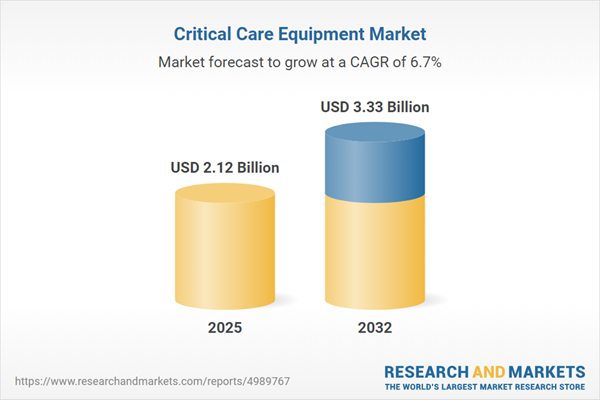Speak directly to the analyst to clarify any post sales queries you may have.
The Critical Care Equipment Market is experiencing sustained transformation as healthcare systems worldwide redefine care delivery through technological integration and regulatory compliance. Decision-makers are increasingly focused on strategies to drive operational efficiency, enhance patient outcomes, and address evolving procurement landscapes.
Market Snapshot: Critical Care Equipment Market Growth and Expansion
From 2024 to 2025, the global critical care equipment market is set to expand from USD 1.98 billion to USD 2.12 billion, maintaining solid growth momentum. With a CAGR of 6.69% projected, the industry is positioned to reach USD 3.33 billion by 2032. This sustained expansion is being shaped by demographic shifts, technological advancements, and regulatory changes that encourage the adoption of advanced, data-driven medical equipment.
Scope & Segmentation: Comprehensive Coverage of Market Dynamics
- Product Type: Capital equipment includes defibrillators (automated external, manual), infusion pumps (elastomeric, syringe, volumetric), patient monitors (multi-parameter, single-parameter), and ventilators (invasive, non-invasive). Disposable equipment covers catheters, oxygen masks, and syringes and needles.
- Mobility: Solutions encompass fixed equipment (standalone, wall-mounted) and portable equipment (cart-mounted devices, handheld devices), aligning with the increasing need for both integrated and mobile care delivery platforms.
- Regional Coverage: The analysis spans the Americas (including North America and Latin America), Europe, the Middle East & Africa, and Asia-Pacific. Each region presents distinct market adoption rates, regulatory frameworks, and procurement strategies that decision-makers must evaluate.
- Key Companies: Assessment covers major industry participants such as GE HealthCare Technologies Inc., Koninklijke Philips N.V., Drägerwerk AG & Co. KGaA, Medtronic plc, Siemens Healthineers AG, Baxter International Inc., Mindray Medical International Limited, B. Braun Melsungen AG, Nihon Kohden Corporation, and Masimo Corporation.
Key Takeaways: Strategic Insights for Senior Decision-Makers
- Interconnected platforms and data-driven technologies are reshaping critical care workflows, with hospitals prioritizing system-wide interoperability and diagnostic accuracy.
- User-centric design is driving the development of portable and home-based critical care solutions, supporting the global rise in chronic conditions and aged populations.
- Collaborative procurement models and outcome-based service agreements are becoming standard practices as healthcare organizations focus on operational cost management and measurable clinical performance.
- Regulatory acceleration has fostered competitive innovation, compelling manufacturers to integrate advanced safety features and compliance-ready functionalities from early-stage development onward.
- Market competition is defined by joint ventures, strategic alliances, and the rapid acquisition of niche technology firms that enhance critical care portfolios and enable regional customization.
Tariff Impact: Navigating U.S. Regulatory Landscape and Supply Chain Realignment
New U.S. tariff policies effective from 2025 have driven a strategic reassessment of supply chains, prompting companies to localize manufacturing and reduce reliance on cross-border sourcing for critical components. These measures are shaping procurement strategies, encouraging industry leaders to pursue collaborations in tariff-exempt regions and revisit total cost of ownership models, influencing maintenance agreements and aftermarket services.
Methodology & Data Sources: Ensuring Market Insight Accuracy
This analysis leverages primary interviews with critical care specialists, biomedical engineers, and procurement leaders, complemented by custom surveys targeting hospital administration and distributor networks. Secondary sources include regulatory filings, patent data, financial reports, white papers, and peer-reviewed publications. Triangulation and expert peer review underpin the data's robustness.
Why This Report Matters: Advanced Intelligence for Senior Stakeholders
- Gain practical insights to refine procurement, innovation, and compliance strategies amid persistent industry transformation.
- Empower decision-makers to respond proactively to supply chain pressures and evolving reimbursement and policy requirements.
- Uncover actionable opportunities for strategic partnerships, technology adoption, and regional expansion to ensure sustainable competitiveness.
Conclusion
Senior leaders equipped with this report's insights can confidently navigate changing market forces, optimize operations, and drive value-based outcomes in critical care environments.
Additional Product Information:
- Purchase of this report includes 1 year online access with quarterly updates.
- This report can be updated on request. Please contact our Customer Experience team using the Ask a Question widget on our website.
Table of Contents
3. Executive Summary
4. Market Overview
7. Cumulative Impact of Artificial Intelligence 2025
Companies Mentioned
The companies profiled in this Critical Care Equipment market report include:- GE HealthCare Technologies Inc.
- Koninklijke Philips N.V.
- Drägerwerk AG & Co. KGaA
- Medtronic plc
- Siemens Healthineers AG
- Baxter International Inc.
- Mindray Medical International Limited
- B. Braun Melsungen AG
- Nihon Kohden Corporation
- Masimo Corporation
Table Information
| Report Attribute | Details |
|---|---|
| No. of Pages | 198 |
| Published | October 2025 |
| Forecast Period | 2025 - 2032 |
| Estimated Market Value ( USD | $ 2.12 Billion |
| Forecasted Market Value ( USD | $ 3.33 Billion |
| Compound Annual Growth Rate | 6.6% |
| Regions Covered | Global |
| No. of Companies Mentioned | 11 |









